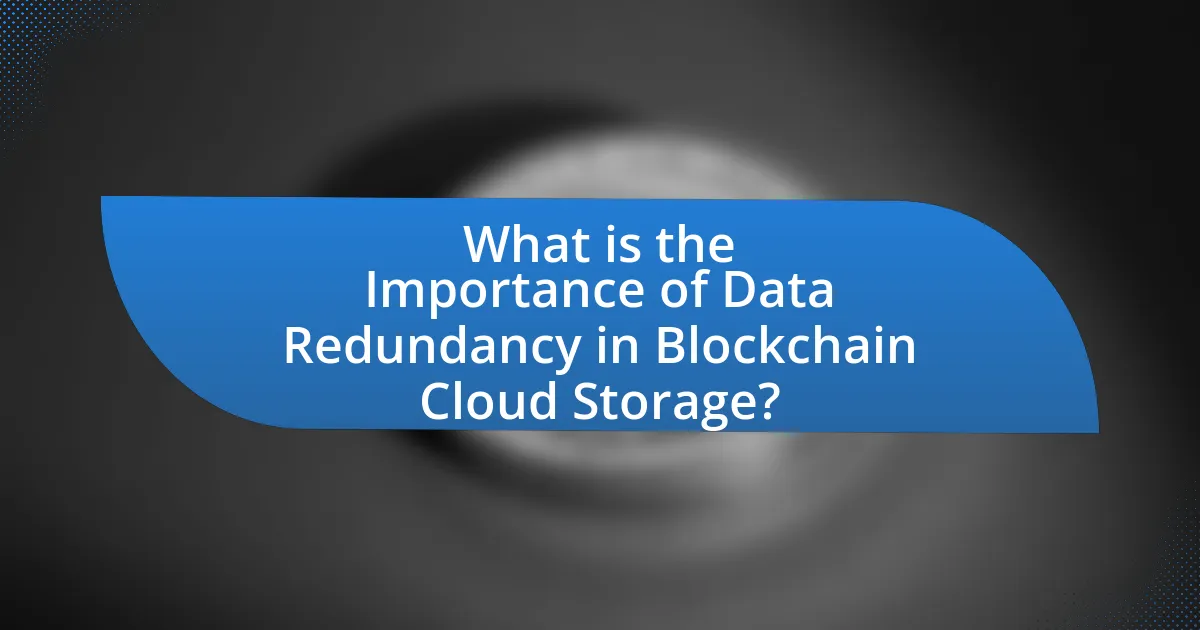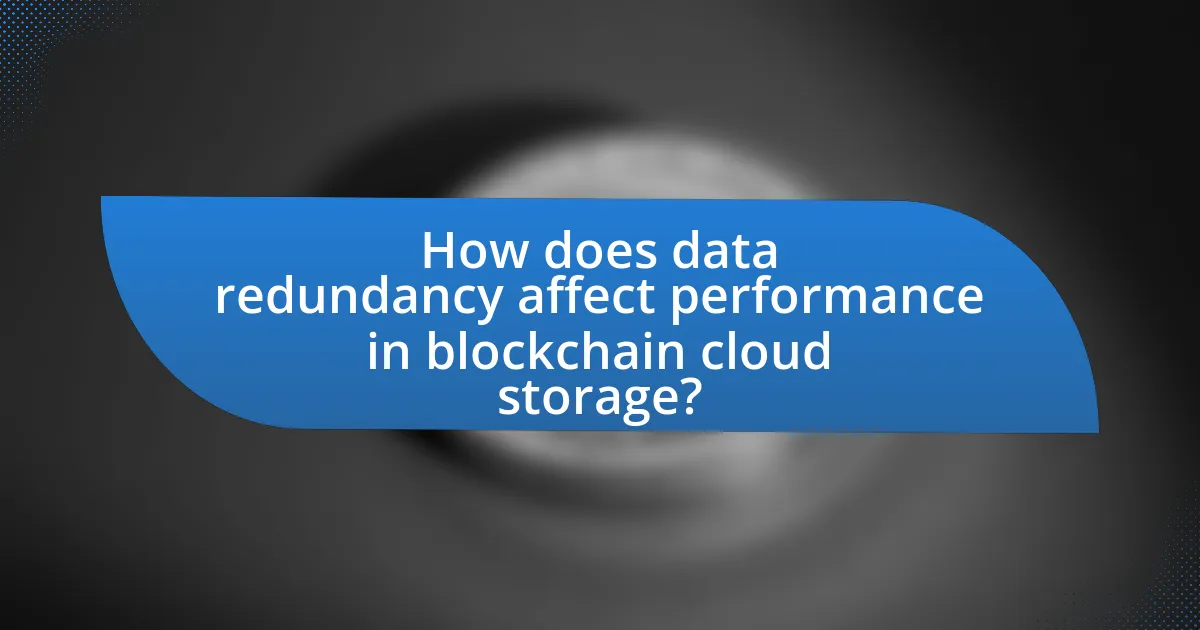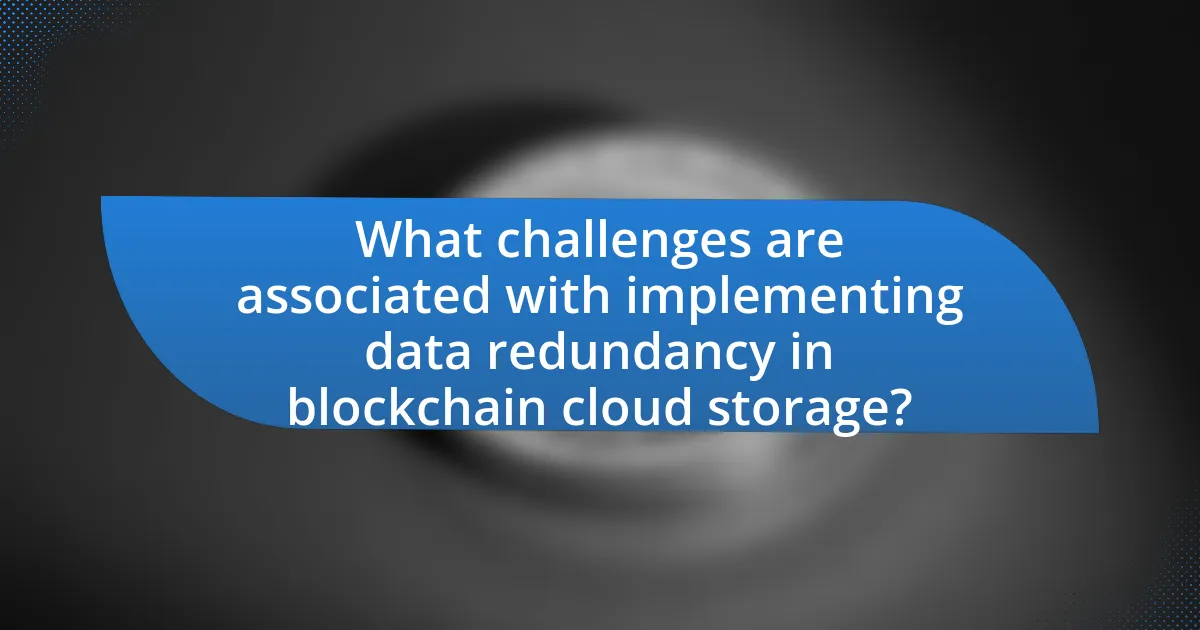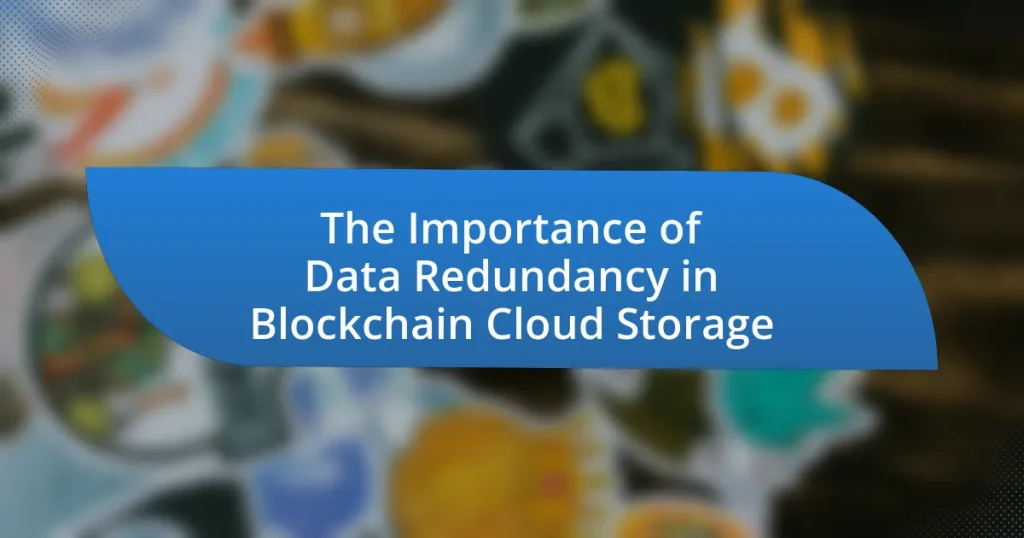Data redundancy in blockchain cloud storage is essential for maintaining data integrity and availability. By creating multiple copies of data across various nodes, blockchain technology reduces the risk of data loss from hardware failures, cyberattacks, or natural disasters, thereby enhancing system resilience. This article explores the significance of data redundancy, its role in ensuring data integrity and security, and the mechanisms employed to implement it within blockchain systems. Additionally, it addresses the challenges and trade-offs associated with redundancy, including storage costs and performance impacts, while highlighting best practices and future trends in data redundancy for blockchain cloud storage.

What is the Importance of Data Redundancy in Blockchain Cloud Storage?
Data redundancy in blockchain cloud storage is crucial for ensuring data integrity and availability. By storing multiple copies of data across various nodes, blockchain technology mitigates the risk of data loss due to hardware failures, cyberattacks, or natural disasters. This redundancy enhances the resilience of the system, as even if one node fails, the data remains accessible from other nodes. Furthermore, studies indicate that decentralized storage solutions, like those utilizing blockchain, can achieve higher reliability rates compared to traditional centralized systems, as they distribute the risk across a network rather than relying on a single point of failure.
Why is data redundancy crucial in blockchain technology?
Data redundancy is crucial in blockchain technology because it enhances data integrity and availability. By storing multiple copies of data across a decentralized network, blockchain ensures that even if some nodes fail or are compromised, the information remains accessible and unaltered. This redundancy protects against data loss and tampering, as evidenced by the fact that blockchain networks like Bitcoin maintain thousands of copies of the same transaction data, making it nearly impossible to alter historical records without consensus from the majority of nodes.
What role does data redundancy play in ensuring data integrity?
Data redundancy plays a critical role in ensuring data integrity by providing multiple copies of data across different locations or systems. This duplication allows for the recovery of accurate data in the event of corruption, loss, or unauthorized alterations. For instance, in blockchain cloud storage, data is replicated across numerous nodes, which means that even if one node fails or is compromised, the original data remains intact and accessible from other nodes. This mechanism not only protects against data loss but also enhances the reliability of the data, as discrepancies can be identified and corrected through consensus among the redundant copies.
How does data redundancy enhance security in blockchain cloud storage?
Data redundancy enhances security in blockchain cloud storage by ensuring that multiple copies of data are stored across various nodes, which mitigates the risk of data loss or corruption. This distributed nature of data storage means that even if one node is compromised or fails, the data remains accessible and intact from other nodes. Additionally, redundancy helps in preventing unauthorized access, as attackers would need to breach multiple nodes simultaneously to alter or delete data, making it significantly more difficult to manipulate the blockchain. The decentralized architecture of blockchain, combined with redundancy, creates a robust security framework that protects against data breaches and enhances overall data integrity.
What are the key features of data redundancy in blockchain cloud storage?
Data redundancy in blockchain cloud storage is characterized by multiple copies of data distributed across various nodes to enhance reliability and availability. This feature ensures that even if one node fails or is compromised, the data remains accessible from other nodes, thereby preventing data loss. Additionally, data redundancy facilitates faster data retrieval, as requests can be served from multiple sources, reducing latency. Furthermore, it strengthens security by making it more difficult for malicious actors to alter or delete data, as they would need to manipulate multiple copies across the network. These features collectively contribute to the robustness and resilience of blockchain cloud storage systems.
How does decentralized storage contribute to data redundancy?
Decentralized storage enhances data redundancy by distributing data across multiple nodes in a network rather than storing it in a single location. This distribution ensures that if one node fails or becomes inaccessible, the data remains available from other nodes, thereby reducing the risk of data loss. For instance, in blockchain cloud storage systems, data is often replicated across various geographical locations, which further protects against localized failures or attacks. This method of data management not only increases reliability but also improves data integrity, as multiple copies can be verified against each other to detect any discrepancies.
What mechanisms are used to implement data redundancy in blockchain systems?
Data redundancy in blockchain systems is primarily implemented through mechanisms such as data replication, consensus algorithms, and distributed ledger technology. Data replication ensures that copies of the same data are stored across multiple nodes, enhancing availability and fault tolerance. Consensus algorithms, like Proof of Work and Proof of Stake, validate transactions and maintain consistency across the network, ensuring that all nodes have the same data. Distributed ledger technology inherently creates multiple copies of the blockchain across various nodes, which protects against data loss and corruption. These mechanisms collectively ensure that data remains accessible and reliable, even in the event of node failures or attacks.

How does data redundancy affect performance in blockchain cloud storage?
Data redundancy positively affects performance in blockchain cloud storage by enhancing data availability and reliability. When multiple copies of data are stored across various nodes, the system can quickly retrieve information even if some nodes fail or become unreachable. This redundancy minimizes downtime and ensures continuous access to data, which is crucial for applications requiring high availability. Additionally, data redundancy can improve read performance, as requests can be distributed across multiple nodes, reducing the load on any single node. Studies have shown that systems employing redundancy can achieve faster recovery times and maintain operational efficiency, particularly in decentralized environments where node failures are more common.
What impact does data redundancy have on data retrieval times?
Data redundancy generally increases data retrieval times due to the presence of multiple copies of the same data. When a system retrieves data, it may need to sift through these duplicates, which can lead to longer access times. For instance, in a blockchain cloud storage system, if data is stored redundantly across multiple nodes, the retrieval process may involve querying several nodes to ensure data integrity and consistency, thereby increasing the time taken to access the required information. Studies have shown that while redundancy can enhance data availability and fault tolerance, it can also introduce latency in data retrieval processes, particularly in systems where data consistency checks are necessary.
How does redundancy influence the overall efficiency of blockchain operations?
Redundancy enhances the overall efficiency of blockchain operations by ensuring data integrity and availability. In blockchain systems, multiple copies of data are stored across various nodes, which mitigates the risk of data loss due to node failures or malicious attacks. This distributed nature allows for faster recovery and consistent access to information, as the system can rely on alternative nodes to provide the necessary data. For instance, Bitcoin’s blockchain achieves high reliability through its decentralized structure, where thousands of nodes maintain copies of the entire ledger, thus facilitating seamless transactions even in the event of individual node failures.
What are the trade-offs between redundancy and storage costs?
Redundancy in data storage enhances data availability and reliability but incurs higher storage costs. When data is duplicated across multiple locations, the likelihood of data loss decreases, ensuring that users can access their information even in the event of hardware failures or cyberattacks. However, this increased reliability comes at a financial cost, as maintaining multiple copies of data requires more storage space and resources. For instance, a study by the International Data Corporation (IDC) indicates that organizations can spend up to 30% of their IT budgets on data storage, with redundancy being a significant factor in these expenses. Thus, while redundancy improves data resilience, it also leads to increased operational costs, necessitating a careful balance between the two.
How does data redundancy support disaster recovery in blockchain cloud storage?
Data redundancy supports disaster recovery in blockchain cloud storage by ensuring that multiple copies of data are stored across different nodes, which enhances data availability and resilience. In the event of a node failure or data corruption, the system can quickly retrieve the necessary information from alternative copies, minimizing downtime and data loss. This approach is crucial in blockchain environments, where data integrity and accessibility are paramount, as it allows for continuous operation even during adverse conditions. For instance, blockchain networks like Bitcoin utilize a decentralized structure where data is replicated across thousands of nodes, providing a robust mechanism for disaster recovery.
What strategies are employed for effective data recovery using redundancy?
Effective data recovery using redundancy employs strategies such as data mirroring, RAID (Redundant Array of Independent Disks) configurations, and distributed storage systems. Data mirroring involves creating exact copies of data across multiple storage devices, ensuring that if one device fails, the data remains accessible from another. RAID configurations, particularly RAID 1 and RAID 5, utilize multiple disks to provide fault tolerance and improve data recovery speed by distributing data and parity information. Distributed storage systems, often used in blockchain cloud storage, replicate data across various nodes, enhancing resilience against data loss and enabling quick recovery through decentralized access. These strategies are validated by their widespread implementation in enterprise-level data management, demonstrating their effectiveness in maintaining data integrity and availability.
How does redundancy mitigate the risks of data loss in blockchain systems?
Redundancy mitigates the risks of data loss in blockchain systems by ensuring that multiple copies of data are stored across various nodes in the network. This distributed storage approach means that even if one or several nodes fail or become compromised, the data remains accessible from other nodes, thereby preserving its integrity and availability. For instance, in a blockchain like Bitcoin, data is replicated across thousands of nodes, making it nearly impossible for data loss to occur due to a single point of failure. This redundancy is a fundamental characteristic of blockchain technology, enhancing resilience against attacks and system failures, as evidenced by the decentralized nature of the network which has successfully maintained data integrity since its inception in 2009.

What challenges are associated with implementing data redundancy in blockchain cloud storage?
Implementing data redundancy in blockchain cloud storage presents several challenges, including increased storage costs, complexity in data management, and potential performance issues. Increased storage costs arise because maintaining multiple copies of data requires more resources, which can be financially burdensome for organizations. Complexity in data management occurs as ensuring consistency and synchronization across redundant data copies can complicate operations, especially in decentralized environments. Performance issues may arise due to the overhead associated with managing redundancy, which can slow down data retrieval and processing times. These challenges highlight the need for careful planning and resource allocation when integrating data redundancy into blockchain cloud storage systems.
What are the technical limitations of data redundancy in blockchain?
The technical limitations of data redundancy in blockchain include increased storage requirements, slower transaction speeds, and potential data inconsistency. Increased storage requirements arise because every node in a blockchain network must maintain a complete copy of the entire blockchain, leading to significant data bloat. Slower transaction speeds occur as the network must process and validate multiple copies of data across nodes, which can hinder scalability. Additionally, potential data inconsistency can emerge if nodes become out of sync due to network latency or failures, complicating consensus mechanisms. These limitations highlight the challenges of implementing effective data redundancy in blockchain systems.
How do scalability issues affect data redundancy solutions?
Scalability issues significantly impact data redundancy solutions by limiting their effectiveness and efficiency as system demands increase. As the volume of data grows, traditional redundancy methods, such as replication across multiple nodes, can lead to increased latency and resource consumption, ultimately hindering system performance. For instance, a study by the University of California, Berkeley, highlighted that as data scales, the overhead associated with maintaining redundant copies can lead to diminishing returns in data retrieval speeds and increased costs in storage management. This demonstrates that without addressing scalability, data redundancy solutions may become less viable, resulting in potential data loss or accessibility issues in blockchain cloud storage environments.
What are the potential security vulnerabilities related to data redundancy?
Data redundancy can introduce several potential security vulnerabilities, including data breaches, unauthorized access, and data integrity issues. When multiple copies of data exist, the risk of exposure increases, as attackers may target less secure locations where redundant data is stored. Additionally, if redundancy mechanisms are not properly secured, unauthorized users may gain access to sensitive information. Furthermore, inconsistencies between redundant data copies can lead to integrity issues, where outdated or incorrect data is used, potentially compromising decision-making processes. These vulnerabilities highlight the need for robust security measures to protect redundant data in blockchain cloud storage environments.
What best practices can be adopted for effective data redundancy in blockchain cloud storage?
To achieve effective data redundancy in blockchain cloud storage, implementing a multi-layered storage strategy is essential. This involves distributing data across multiple nodes and geographic locations to ensure availability and resilience against failures. Utilizing decentralized storage solutions, such as IPFS (InterPlanetary File System), enhances redundancy by allowing data to be stored in a distributed manner, reducing the risk of data loss. Additionally, employing regular data replication and backup processes ensures that multiple copies of data exist, further safeguarding against corruption or loss. Research indicates that decentralized storage systems can improve data availability by up to 99.99%, demonstrating the effectiveness of these practices in maintaining data integrity and accessibility.
How can organizations optimize their redundancy strategies?
Organizations can optimize their redundancy strategies by implementing a multi-layered approach that includes data replication, geographic distribution, and automated failover systems. This strategy ensures that data remains accessible and secure even in the event of hardware failures or cyberattacks. For instance, using blockchain technology allows for decentralized data storage, which inherently provides redundancy through multiple copies across different nodes. Research indicates that organizations utilizing blockchain for cloud storage can achieve up to 99.99% data availability, significantly reducing the risk of data loss. Additionally, regular testing of redundancy systems and updating protocols based on evolving threats further enhances the effectiveness of these strategies.
What tools and technologies are recommended for implementing data redundancy?
Recommended tools and technologies for implementing data redundancy include RAID (Redundant Array of Independent Disks), cloud storage solutions like Amazon S3 and Google Cloud Storage, and distributed file systems such as Hadoop HDFS. RAID configurations, such as RAID 1 and RAID 5, provide redundancy through mirroring and parity, ensuring data availability even in case of hardware failure. Cloud storage solutions offer built-in redundancy features, automatically replicating data across multiple locations to prevent loss. Distributed file systems enhance redundancy by storing data across various nodes, allowing for fault tolerance and high availability. These technologies are widely adopted in the industry, demonstrating their effectiveness in maintaining data integrity and accessibility.
What future trends can we expect in data redundancy for blockchain cloud storage?
Future trends in data redundancy for blockchain cloud storage include increased use of decentralized storage solutions, enhanced redundancy protocols, and integration of artificial intelligence for data management. Decentralized storage systems, such as IPFS and Filecoin, are gaining traction as they distribute data across multiple nodes, reducing single points of failure and improving redundancy. Enhanced redundancy protocols, like sharding and erasure coding, are being developed to optimize data recovery and minimize storage costs. Additionally, artificial intelligence is being leveraged to predict data access patterns and automate redundancy processes, ensuring efficient storage management. These trends are supported by the growing demand for secure, reliable, and scalable cloud storage solutions in various industries.
How might advancements in technology influence data redundancy practices?
Advancements in technology significantly influence data redundancy practices by enabling more efficient storage solutions and automated redundancy management. For instance, the development of distributed ledger technologies, such as blockchain, allows for decentralized data storage, which inherently provides redundancy across multiple nodes. This reduces the risk of data loss and enhances data integrity, as each node maintains a copy of the data. Additionally, advancements in artificial intelligence and machine learning facilitate predictive analytics that can optimize redundancy strategies by identifying which data sets require duplication based on usage patterns and criticality. These technologies collectively enhance the reliability and efficiency of data redundancy practices in blockchain cloud storage environments.
What role will artificial intelligence play in enhancing data redundancy?
Artificial intelligence will enhance data redundancy by optimizing data storage processes and improving error detection. AI algorithms can analyze data patterns to identify redundancy needs, ensuring that critical data is backed up efficiently across multiple nodes in a blockchain cloud storage system. For instance, AI can automate the replication of data across various locations, reducing the risk of data loss and ensuring high availability. Additionally, AI-driven predictive analytics can forecast potential failures in storage systems, allowing for proactive measures to maintain redundancy. This capability is supported by studies showing that AI can significantly reduce downtime and data loss incidents in cloud environments, thus reinforcing the importance of data redundancy in blockchain cloud storage.


